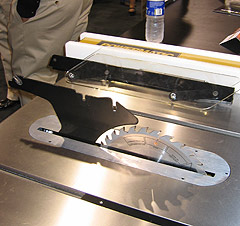
How do you get the blade true with the fence, and how close is close enough? .004″ or .001″?
Michael Dresdner: You set the fence to the slots first, then set the blade to the fence by loosening three of the four bolts that hold the trunion and shifting it until the blade is parallel. Close enough is as close as you can do it or measure it.
Ellis Walentine: First, if you’re using a dial indicator that is accuratelyreferenced in the miter gauge slot, you should be able to get it very close to dead parallel. .004 isn’t a lot, but it’s a large enough difference to result in unnecessary tooth marks on the sawn edges of your crosscuts.
One of the problems with trying to check for parallel is that, if you’re using a blade, the blade must be dead flat to get a reliable reading. The fact is that few blades are ever dead flat, especially when they’re at rest. They flatten somewhat when the saw is generating all that centrifugal force on them. This is why blades are tensioned for the arbor rotation speed.
The way around this problem is to use a reference plate or bar instead of a blade to check the parallelism to the miter gauge slot. Table saw manufacturers use super-accurate, machined steel plates the size of a saw blade but about ¼” thick or thicker. But you could get the same accuracy with a steel bar about ¼” thick by about 1 ½” wide by about 12″ long with a perfectly reamed 5/8″ hole on center about two or three inches from one end. Mount that on your arbor and swing it from a forward position to a rearward position to take your measurements.
Shifting the top is easy. Just slightly loosen the four bolts that hold the top to the base cabinet, tweak the top as necessary, and then tighten the bolts again and recheck. You shouldn’t have to disassemble anything else for this tiny shift.





